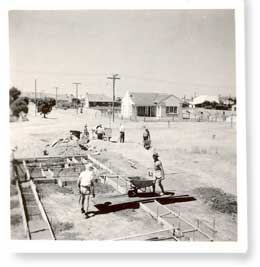19 September 2013
 The war was over and thousands of South Australians were looking for new homes and a chance to settle down. But years of fighting and years of directing supplies to the war effort had left a shortage of homes, a shortage of materials and even a shortage of know how.
The war was over and thousands of South Australians were looking for new homes and a chance to settle down. But years of fighting and years of directing supplies to the war effort had left a shortage of homes, a shortage of materials and even a shortage of know how.
The story of how South Australians bandied together to build new suburbs and new lives post WWII is just one example of the fascinating histories of everyday things that will be in the spotlight at the Biennial National Conference of the Oral History Association of Australia and the 21st State History Conference in Adelaide on September 21 to 24 – She said, He said: reading, writing and recording history.
Jointly hosted by History SA, The Oral History Association of Australia and the University of South Australia’s David Unaipon College of Indigenous Education and Research, the four-day program includes workshops, tours, lectures and presentations from local and international guests.
As part of the conference a new monograph telling the story of how South Australians played a part in building about 400 new homes in the 20 years after the end of WWII will be launched.
The monograph, ‘Not for Ourselves Alone’: The South Australian Home Builders’ Club, 1945-1965, detailing the history of the SA Home Builder’s Club (SABC) has relied on15 oral histories produced through interviews with club members and their spouses and children, to build a picture of post war Adelaide and the community collaboration that delivered homes to hundreds of young families.
Co-authored by Drs Julie Collins and Christine Garnaut the monograph is published by UniSA’s Architecture Museum and Crossing Press, Sydney.
“In listening to the oral histories you learn so much more than just the facts, you discover the relationships that gave the Club its character, the sense of community that kept people going and so much more detail about the impact the club had on people’s lives,” Dr Garnaut says.
“The SAHBC relied on members working collaboratively in a framework where they could barter their time and skills to help each other to build a house – there was no exchange of money in the whole process.
“Most of the ‘builders’ were without trade skills but they taught each other and worked in teams to help pass on skills. When you had recorded 200 hours work on other people’s houses the foundations of your own home could be poured.”
The launch of the monograph will be just one event in an action-packed program that kicks off with international keynote speaker Prof Rina Benmayor from California State speaking on the revival of Salinas’ Chinatown in California.
The other keynote, Professor Marian Quartly from Monash University will present on the history of adoption in Australia and a project documenting this history in the past four years leading up to the Australian Government’s apology to people separated by forced adoption practices.
The conference will also include the Annual Lecture of the History Council of South Australia to be delivered at 6pm on September 20 in the Allan Scott auditorium by Prof Alistair Thomson project leader for the Australian Generations Oral History Project.
Other themes at the conference include war and memory, queer voices and diverse histories, history and the stage, 19th century Adelaide and much more.
The full program is available here.
Media contact: Michèle Nardelli office: 08 8302 0966 mobile: 0418 823 673 email: Michele.nardelli@unisa.edu.au



